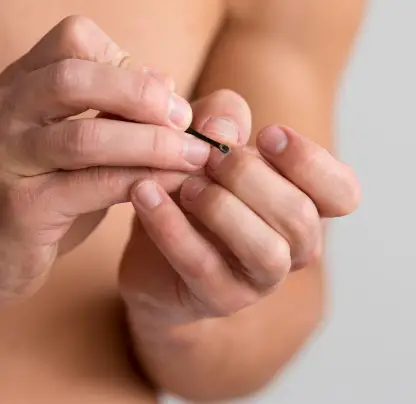Understanding Vertical Nail Ridges: A Comprehensive Health Guide for Adults Over 40
As we progress through middle age, our bodies communicate important information about our health through various subtle changes. One often-overlooked indicator appears right at our fingertips—vertical ridges on our nails. These linear formations that run from the cuticle to the nail tip represent more than mere cosmetic concerns; they serve as potential windows into our overall health status and physiological well-being.
The Science Behind Nail Formation and Structure
Understanding nail ridges requires a foundational knowledge of nail biology and formation. Fingernails consist primarily of keratin, the same structural protein found in hair and skin. This complex protein is manufactured by specialized cells within the nail matrix, located beneath the cuticle at each nail’s base.
The nail matrix functions as a sophisticated biological factory, continuously producing new keratin cells that migrate forward to form the visible nail plate. Under optimal conditions, this process generates smooth, uniform nails that grow approximately 2-3 millimeters monthly. The production system requires adequate nutrition, proper hydration, efficient circulation, and normal cellular function throughout the body.
The nail plate itself comprises multiple layers of compressed keratin cells, creating a structure that balances flexibility with durability. Healthy nails appear smooth and uniform under magnification, with the nail plate’s transparency allowing the underlying nail bed’s pink coloration to show through.
However, this sophisticated production system becomes increasingly susceptible to disruption with advancing age. Changes in circulation, nutrient absorption, hormonal balance, and cellular regeneration can all compromise the nail matrix’s ability to produce uniform keratin, resulting in visible alterations to nail appearance and texture.
Defining Vertical Nail Ridges: Clinical Characteristics
Vertical nail ridges, medically termed longitudinal striations, are raised lines extending from the cuticle area to the nail tip, following the natural direction of nail growth. These formations vary significantly in presentation, ranging from barely perceptible lines detectable only through touch to prominent grooves clearly visible to the naked eye.
Ridge formation occurs when the nail matrix produces keratin inconsistently, creating thickness variations along the nail plate’s length. This phenomenon resembles a manufacturing process where machinery occasionally produces slightly different outputs—the overall product remains functional, but minor variations become visible over time.
For most individuals over 40, vertical ridges represent a normal component of the aging process, similar to how skin develops fine lines or hair changes texture. Age-related ridges typically appear gradually and affect multiple nails simultaneously, though they may be more pronounced on frequently used fingers, particularly thumbs and index fingers.
These ridges generally maintain uniform appearance and coloration, matching the nail’s natural color. They typically don’t cause pain or discomfort, though very pronounced ridges might occasionally catch on fabric or feel rough to touch.
Age-Related Changes and Nail Health Impact
The relationship between aging and nail changes involves multiple biological processes that gradually alter nail development and appearance. After age 40, several key changes occur that directly impact nail health, making vertical ridges increasingly common.
Cellular Regeneration and Matrix Function
Advancing age brings a natural slowdown in cellular regeneration rates throughout the body. This change affects nail matrix cells responsible for keratin production, causing them to function less efficiently and sometimes less uniformly. The result often manifests as variations in keratin production that appear as vertical ridges along the nail’s length.
This regeneration slowdown is part of the same biological process causing other age-related changes, including slower wound healing, reduced skin elasticity, and hair texture modifications. The nail matrix, composed of rapidly dividing cells, proves particularly susceptible to these age-related cellular function changes.
Additionally, the nail matrix becomes less responsive to growth signals and nutritional inputs with aging. This reduced responsiveness can lead to periods of slightly irregular keratin production, creating the uneven texture that appears as vertical ridges.
Circulation and Nutrient Delivery
Proper nail formation requires adequate blood flow to deliver nutrients and oxygen to nail matrix cells. Aging often brings reduced circulation efficiency to extremities, particularly fingers and toes. This decreased circulation can affect the nail matrix’s optimal functioning, contributing to ridge formation and other nail changes.
Reduced circulation impact on nail health becomes more apparent in individuals with conditions affecting blood flow, such as diabetes, cardiovascular disease, or peripheral artery disease. However, even healthy aging involves some circulation efficiency reduction, potentially contributing to nail changes in otherwise healthy individuals.
Poor circulation also affects the delivery of nutrients essential for nail health, including proteins, vitamins, and minerals. When these nutrients don’t reach the nail matrix in adequate quantities, keratin production quality can suffer, leading to weaker nails with more pronounced ridges and textural changes.
Hormonal Influences
Hormonal fluctuations occurring with aging, particularly in women during perimenopause and menopause, can significantly impact nail health. Estrogen plays a crucial role in maintaining healthy skin and nail structure, and declining estrogen levels can lead to drier, more brittle nails prone to developing ridges.
These hormonal changes affect not only nail texture and strength but also growth rate and moisture retention ability. Lower estrogen levels can reduce natural oil production in nails, leading to drier nail plates more likely to show surface irregularities and ridges.
Men also experience gradual hormonal changes with aging. Declining testosterone levels can affect overall protein synthesis, including keratin production for nail formation, potentially contributing to nail changes and ridge formation.
Nutritional Factors and Nail Health
The relationship between nutrition and nail health becomes increasingly critical with age, as deficiencies become more likely to manifest as visible nail appearance and structure changes. After 40, bodies often become less efficient at absorbing and utilizing nutrients, making adequate nutrition even more crucial for maintaining healthy nails.
Essential Nutrients for Optimal Nail Health
Biotin (Vitamin B7) plays a crucial role in keratin production and nail strength. While severe biotin deficiency is rare in developed countries, mild deficiencies can occur, particularly in older adults with reduced absorption or increased nutritional needs.
Iron deficiency represents another common nutritional issue affecting nail health. Iron is essential for proper cellular function and oxygen transport, and deficiency can lead to weak, ridged nails. Iron deficiency becomes more common with age due to reduced absorption, dietary changes, and potential blood loss from various sources.
Zinc plays a vital role in protein synthesis and cellular repair, making it essential for healthy nail formation. Zinc deficiency can cause various nail abnormalities, including ridges, white spots, and slow growth. Older adults face increased risk for zinc deficiency due to reduced absorption and potentially inadequate dietary intake.
Magnesium participates in numerous enzymatic processes affecting nail health, including protein synthesis and cellular energy production. Magnesium deficiency can contribute to weak, brittle nails and may exacerbate ridge formation.
Protein and Amino Acid Requirements
Since nails consist primarily of keratin protein, adequate protein intake is essential for maintaining nail health. With aging, protein needs may actually increase due to decreased efficiency in protein utilization, yet many older adults consume less protein than younger individuals.
Protein quality also matters, as certain amino acids prove particularly important for keratin formation. Cysteine, methionine, and other sulfur-containing amino acids are especially crucial for creating strong, healthy nails. These amino acids are found in foods such as eggs, fish, poultry, and dairy products.
Environmental and Lifestyle Factors
Environmental conditions and lifestyle choices significantly impact nail health, with effects often becoming more pronounced with age. Understanding these factors helps explain why nail ridges become more common after 40 and provides insight into prevention strategies.
Moisture and Hydration Considerations
Environmental moisture exposure and retention represent significant factors affecting nail health. With aging, skin and nails naturally become drier due to reduced oil production and decreased water retention capacity. This natural drying process makes nails more brittle and prone to developing surface irregularities like ridges.
Frequent exposure to water, soaps, and cleaning chemicals can exacerbate nail drying by stripping away natural oils and moisture. Many people over 40 have accumulated decades of exposure to these drying agents, potentially contributing to long-term nail texture and appearance changes.
Occupational and Activity-Related Factors
Certain occupations and activities can increase ridge development likelihood through repeated trauma or chemical exposure. Healthcare workers, food service employees, hairstylists, and others who frequently wash hands or use chemicals may experience more pronounced nail changes.
Repetitive activities placing stress on nails, such as typing, playing musical instruments, or manual labor, can also contribute to nail changes over time. The cumulative effect of these activities becomes more apparent as nails become less resilient with age.
When Vertical Ridges Signal Health Concerns
While most vertical nail ridges represent benign aging signs, certain characteristics or accompanying symptoms can indicate underlying health issues requiring medical attention. Understanding these warning signs proves crucial for determining when ridges might represent more than cosmetic concerns.
Sudden Onset or Rapid Changes
Vertical ridges appearing suddenly or changing rapidly in appearance may indicate underlying health problems rather than normal aging. Normal age-related ridges typically develop gradually over months or years, becoming slowly more noticeable over time.
Rapid ridge appearance changes, particularly affecting only one or two nails, might suggest local trauma, infection, or other localized problems. If ridges appear suddenly across all nails, this could indicate systemic health issues affecting the entire body.
Associated Health Conditions
Several health conditions can cause or contribute to vertical nail ridge development beyond normal aging:
Thyroid Disorders: Both hyperthyroidism and hypothyroidism can affect nail growth and appearance through their impact on metabolism and cellular function.
Autoimmune Conditions: Conditions such as rheumatoid arthritis, lupus, or alopecia areata can affect nail health through inflammatory processes or immune system dysfunction.
Circulatory Problems: Poor circulation to extremities can affect nail matrix function, leading to ridges and other nail abnormalities.
Professional Medical Consultation
While most vertical nail ridges are harmless aging signs, certain situations warrant professional medical evaluation to rule out underlying health conditions or provide appropriate treatment.
Seek medical attention if nail ridges are accompanied by dark streaks or bands, significant pain or tenderness, signs of infection, rapid appearance changes, or asymmetrical nail involvement.
Healthcare providers can help determine whether nail changes relate to normal aging, lifestyle factors, or underlying health conditions requiring specific treatment through comprehensive health assessment and specialized testing when indicated.
Conclusion
Vertical nail ridges after age 40 represent a complex interplay of aging processes, environmental factors, nutritional status, and overall health. While these ridges most commonly represent benign signs of normal aging, understanding their causes and characteristics helps distinguish between expected changes and potential health concerns.
Effective management lies in adopting a comprehensive approach addressing multiple contributing factors, including maintaining adequate nutrition and hydration, protecting nails from environmental damage, and supporting overall health through appropriate lifestyle choices. Regular monitoring combined with attention to overall wellness provides the optimal strategy for maintaining nail health throughout the aging process.

Lila Hart is a dedicated Digital Archivist and Research Specialist with a keen eye for preserving and curating meaningful content. At TheArchivists, she specializes in organizing and managing digital archives, ensuring that valuable stories and historical moments are accessible for generations to come.
Lila earned her degree in History and Archival Studies from the University of Edinburgh, where she cultivated her passion for documenting the past and preserving cultural heritage. Her expertise lies in combining traditional archival techniques with modern digital tools, allowing her to create comprehensive and engaging collections that resonate with audiences worldwide.
At TheArchivists, Lila is known for her meticulous attention to detail and her ability to uncover hidden gems within extensive archives. Her work is praised for its depth, authenticity, and contribution to the preservation of knowledge in the digital age.
Driven by a commitment to preserving stories that matter, Lila is passionate about exploring the intersection of history and technology. Her goal is to ensure that every piece of content she handles reflects the richness of human experiences and remains a source of inspiration for years to come.
